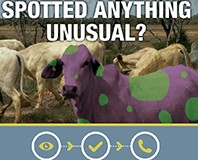Read the latest information on
Foot-and-mouth disease
 Have you spotted anything unusual on your property? Well, prawn farmers on the Logan River in Queensland have literally been spotting unusual spots – aptly identified as white spot disease.
Have you spotted anything unusual on your property? Well, prawn farmers on the Logan River in Queensland have literally been spotting unusual spots – aptly identified as white spot disease.
There is now a concerted effort underway to detect further cases, enforce movement controls in the Logan River area and hopefully eradicate the disease. This outbreak has highlighted some important lessons for all livestock industries.
White spot disease is a viral infection that affects crustaceans. Although there had been an outbreak of white spot disease in Darwin in 2000, Australia was considered free from white spot disease, and this is the first confirmed outbreak in an aquaculture setting.
The disease was officially confirmed in November last year, with seven infected farms so far, and is having a significant impact on the local prawn farming community.
Animal Health Australia’s Executive Manager Biosecurity and Product Integrity Services, Duncan Rowland, said the white spot disease outbreak is a very good example of how significant diseases can spread regardless of whether you are farming water based livestock or terrestrial livestock.
“Animal diseases can spread swiftly and very quickly shut down entire regional industries, as we have seen with white spot disease,” Mr Rowland said.
Diseases like mad cow disease and scrapie can be introduced by feeding imported diseased animal products to sheep and cattle. This is why we have stringent import restrictions on animal products into Australia and the ruminant feed ban in place.”
“White spot disease can spread through the movement of infected animals or contaminated water. Birds that feed on and move infected animals can also spread the disease. A number of terrestrial diseases in our livestock are spread in a similar fashion: just substitute contaminated water with wind and you get the idea,” Mr Rowland said.
Mr Rowland reinforced the main points for all livestock producers that monitoring and reporting and having a good biosecurity action plan in place are the key ingredients in surviving an emergency animal disease outbreak.
“First and foremost, monitor your livestock. Are they lame, are they acting differently or simply not thriving? If so and you are just a little unsure about what it is, report it. Call the Emergency Animal Disease Hotline on 1800 675 888.
“All producers should also have a plan for operating during and surviving an emergency animal disease outbreak. The Farm Biosecurity website has a wealth of information on this and the Preparing your business to survive: Risk management planning for an emergency animal disease outbreak manual is a vital tool to help you prepare,” Mr Rowland said.
Producers concerned about white spot disease can visit the Queensland Department of Agriculture and Fisheries websitewhere you will find regular updates and facts about the disease.